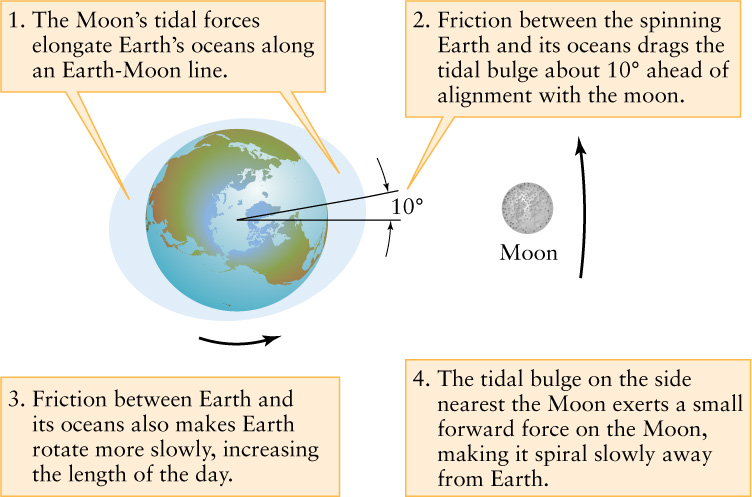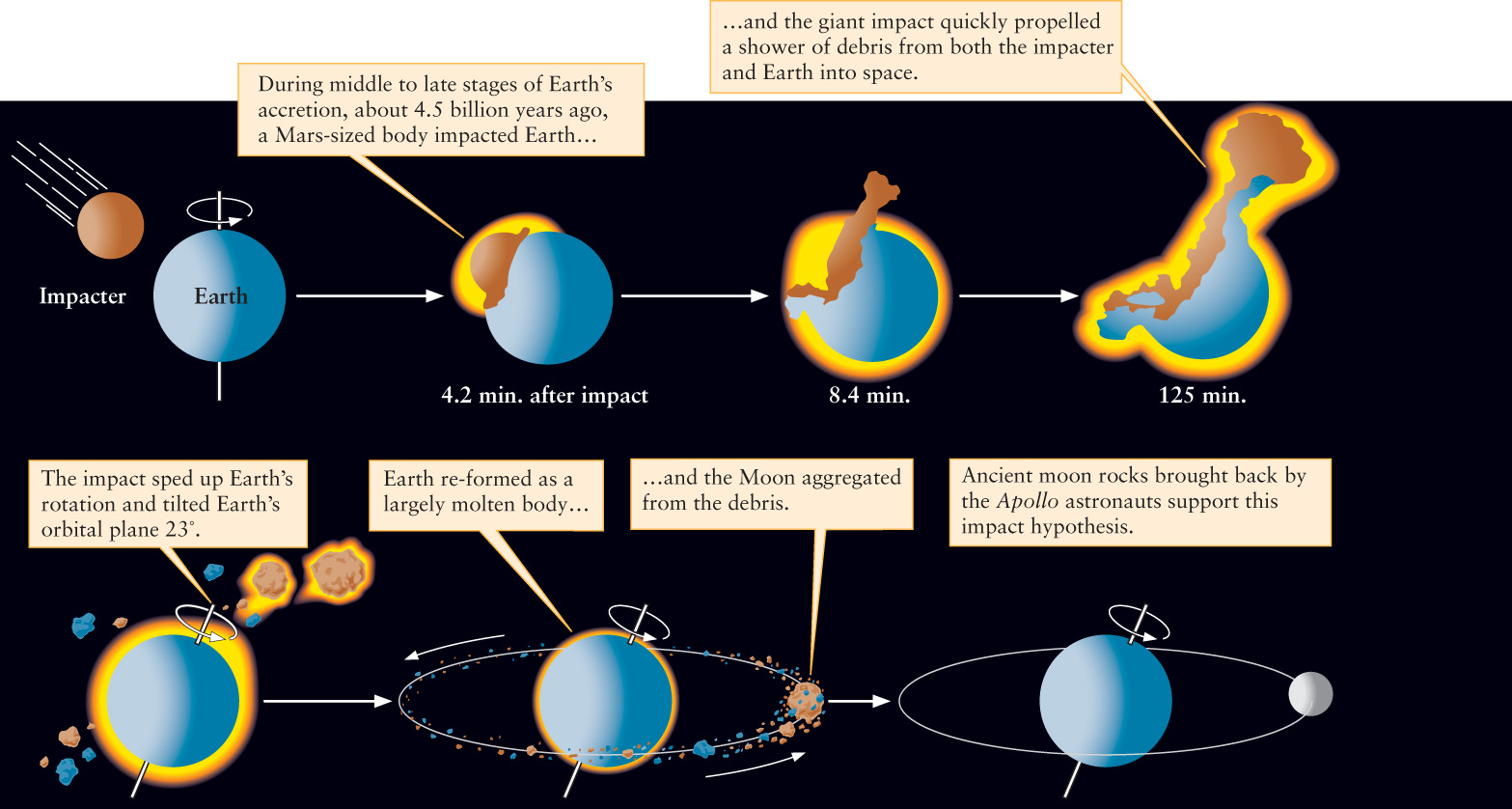10-5 The Moon probably formed from debris cast into space when a huge protoplanet struck the young Earth
 The lunar rocks collected by the Apollo and Luna missions have provided essential information about the history of the Moon. In particular, they have helped astronomers come to a consensus about one of the most important questions in lunar science: Where did the Moon come from?
The lunar rocks collected by the Apollo and Luna missions have provided essential information about the history of the Moon. In particular, they have helped astronomers come to a consensus about one of the most important questions in lunar science: Where did the Moon come from?
The Receding Moon
Seventy years before the first spacecraft landed on the Moon, the British astronomer George Darwin (second son of the famous evolutionist Charles Darwin) deduced that the Moon must be slowly moving away from Earth. He began with the notion that the Moon’s tidal forces elongate the oceans into a football shape (see Section 4-8, especially Figure 4-26). However, the long axis of this “football” does not point precisely at the Moon. Earth spins on its axis more rapidly than the Moon revolves around Earth, and this rapid rotation carries the tidal bulge about 10° ahead of a line connecting Earth and the Moon (Figure 10-20). This misaligned bulge produces a small but steady gravitational force that tugs the Moon forward, adding energy to the Moon’s orbit. As we saw in Section 4-7, increasing the energy of an orbit increases its semimajor axis. Therefore, Earth’s tidal bulge tugs the Moon into an ever larger orbit. In other words, Darwin predicted that the Moon must be spiraling away from Earth.

It became possible to test Darwin’s predictions with the aid of a simple device that the Apollo 11, 14, and 15 and Luna 21 missions left on the Moon—a set of reflectors, similar to the orange and red ones found in automobile taillights. Since 1969, scientists on Earth have been firing pulses of laser light at these reflectors and measuring very accurately the length of time it takes each pulse to return to Earth. Knowing the speed of light, they can use these data to calculate the distance to the Moon to an accuracy of just 3 centimeters. They have found that the Moon is moving away from Earth at a very gradual rate of 3.8 cm per year—which is just what Darwin predicted!
As the Moon moves away from Earth, its sidereal period is getting longer in accordance with Kepler’s third law (see Section 4-7). At the same time, friction between the oceans and the body of Earth is gradually slowing Earth’s rotation. The length of Earth’s day is therefore increasing, by approximately 0.002 seconds per century. In fact, 400 million years ago, the length of Earth’s day was only 21 hours!
Theories of the Moon’s Origins
These observations mean that in the distant past, Earth was spinning faster than it is now and the Moon was much closer. Darwin theorized that the early Earth may have been spinning so fast that a large fraction of its mass tore away, and this fraction coalesced to form the Moon. This is called the fission theory of the Moon’s origin. Prior to the Apollo program, two other theories were in competition with the fission theory. The capture theory posits that the Moon was formed elsewhere in the solar system and then drawn into orbit about Earth by gravitational forces. By contrast, the co-creation theory proposes that Earth and the Moon were formed at the same time but separately.
One fact used to support the fission theory was that the Moon’s average density (3344 kg/m3) is comparable to that of Earth’s outer layers, as would be expected if the Moon had been flung out of a rapidly rotating proto-Earth. However, the fission theory predicts that lunar and terrestrial rocks should be very similar. In fact, samples returned from the Moon by the Apollo and Luna missions show that the material forming lunar rocks has experienced higher temperatures than rocks on Earth. These higher temperatures are inferred by the presence of fewer volatile elements in lunar rock, which are elements that boil (and escape as gas) at temperatures under 900°C.
 Arguing that the fission theory could not account for a temperature difference, some scientists maintained that the Moon formed elsewhere and was later captured by Earth. They also noted that the plane of the Moon’s orbit is close to the plane of the ecliptic, as would be expected if the Moon had originally been in orbit about the Sun but was later captured by Earth.
Arguing that the fission theory could not account for a temperature difference, some scientists maintained that the Moon formed elsewhere and was later captured by Earth. They also noted that the plane of the Moon’s orbit is close to the plane of the ecliptic, as would be expected if the Moon had originally been in orbit about the Sun but was later captured by Earth.
There are, however, difficulties with the capture theory. If Earth did capture the Moon intact, then some necessary conditions must have been satisfied entirely by chance. It is easiest to understand the required coincidence in terms of orbital energy and speed. Again, from Section 4-7, each semimajor axis of an orbiting object has a certain energy, with larger energies corresponding to lower speeds and larger orbital distances. If an object were passing by too quickly, there would be nothing to slow it down into a captured orbit. If an object came in at a lower speed, nothing could speed it up into a steady orbit before it merged with Earth. Therefore, the only way to simply capture a passing Moon would be if it happened to pass by at just the right speed for its orbital distance from Earth; this seems very unlikely.
Proponents of the co-creation theory argued that it is easier for a planet to capture swarms of tiny rocks. In this theory the Moon formed from just such rocky debris. Great numbers of rock fragments orbited the newborn Sun in the plane of the ecliptic along with the protoplanets. Heat generated in collisions could have baked the volatile elements out of these smaller rock fragments. Then, just as planetesimals accreted to form the proto-Earth in orbit about the Sun, the fragments in orbit about Earth accreted to form the Moon.
The Collisional Ejection Theory
 The present scientific consensus is that none of these three theories—fission, capture, and co-creation—is correct. Instead, the evidence points toward an idea proposed in 1975 by William Hartmann and Donald Davis and independently by Alastair Cameron and William Ward. In this collisional ejection theory, the proto-Earth was struck off-center by a Mars-sized object, and this collision ejected debris from which the Moon formed.
The present scientific consensus is that none of these three theories—fission, capture, and co-creation—is correct. Instead, the evidence points toward an idea proposed in 1975 by William Hartmann and Donald Davis and independently by Alastair Cameron and William Ward. In this collisional ejection theory, the proto-Earth was struck off-center by a Mars-sized object, and this collision ejected debris from which the Moon formed.
The collisional ejection theory agrees with what we know about the early history of the solar system. We saw in Section 8-5 that smaller objects collided and fused together to form the inner planets. Some of these collisions must have been quite spectacular, especially near the end of planet formation, when most of the mass of the inner solar system was contained in a few dozen large protoplanets. The collisional ejection theory proposes that one such object, a Mars-sized protoplanet, struck the proto-Earth about 4.5 billion years ago, about halfway between the age of the solar system (4.56 billion years) and the age of the oldest known Moon rocks (4.47 billion years). Figure 10-21 shows the results of a supercomputer simulation of this cataclysm. In the simulation, energy released during the collision produces a huge plume of vaporized rock that shoots out from the point of impact. As this ejected material cools, it coalesces to form the Moon. The tidal effects depicted in Figure 10-20 then cause the size of the Moon’s orbit to gradually increase.

The difference in chemical composition between lunar rocks and Earth rocks helps to constrain theories of the Moon’s origin
The collisional ejection theory also agrees with many properties of lunar rocks and of the Moon as a whole. For example, rock vaporized by the impact would have been depleted of volatile elements and water, leaving the Moon rocks we now know. If the off-center collision took place after chemical differentiation had occurred on Earth, so that our planet’s iron had sunk to its center, then relatively little iron would have been ejected to become part of the Moon. The lack of iron on Earth’s surface explains the Moon’s low density and the small size of its iron core. It also explains the curiously low iron content found in the South Pole—Aitken Basin (see Figure 10-7), where an ancient impact excavated the surface down to a depth of 12 km. Data from the Clementine spacecraft show that iron concentration in this basin is only 10% (see Figure 10-11), which is far less than the 20–30% concentration at a corresponding depth below Earth’s surface.
An Overview of the Moon’s History
We can now summarize the entire geologic history of the Moon. The surface of the newborn Moon was probably molten for many years, both from heat produced during the formation of the Moon and from the decay of short-lived radioactive isotopes. As the Moon gradually cooled, low-density lava floating on the Moon’s surface began to solidify into the anorthositic crust that exists today. The barrage of rock fragments that ended about 3.8 billion years ago produced the craters that cover the lunar highlands.
During the relatively brief period of the Late Heavy Bombardment between 4.1 and 3.8 billion years ago (see Figure 10-19), more than a dozen asteroid-sized objects, each measuring at least 100 km across, struck the Moon and blasted out the vast mare basins. Meanwhile, heat from the decay of long-lived radioactive elements like uranium and thorium began to melt the inside of the Moon. Great floods of molten rock gushed up from the lunar interior, filling the impact basins and creating the dark basaltic maria we see today.
Very little has happened on the Moon since those ancient times. The most recent geologic activity appears to be wrinklelike scarps forming as the cooling Moon shrinks in size, perhaps within the past few hundred million years. A few relatively fresh craters have been formed, but the astronauts visited a world that has remained largely unchanged for more than 3 billion years. During that same period on Earth, by contrast, the continents have been totally transformed time and time again (see Section 9-3).
Many questions and mysteries still remain. The six American and three Soviet lunar landings have brought back samples from only nine locations, barely scratching the lunar surface. We still know very little about the Moon’s far side and poles. How many craters contain ice deposits at the poles? How much of the Moon’s interior is molten? Just how large is its iron core? How old are the youngest lunar rocks? Did lava flows occur over western Oceanus Procellarum only 2 billion years ago, as crater densities there suggest? Could there still be active volcanoes on the Moon? There is still much to be learned by exploring the Moon.
CONCEPT CHECK 10-5
In the collisional ejection theory, does it matter if Earth has undergone chemical differentiation before the impact?
Yes. The Moon has a lower average density than Earth, indicating a lower iron fraction. If Earth’s iron sank before the impact, then outer material forming the Moon would be lower in iron.